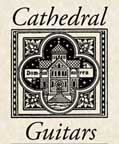|
|
5. Repertoire
It may come as a surprise to guitarists to learn that Coste wrote
for the seven string, Legnani for the eight string, and Carulli
for the ten string, but what else is there? Of course, all works
with a bass-D tuning (and the very few with bass-C tuning) can
be counted. Beyond this, there is Ohana's distinguished work
for the re-entrant-tuned ten-string, cf. ref. 2, so eloquently
championed by Jonathan Leathwood. Janet Marlow's website gives
examples of contemporary compositions, not only in her tuning
system, but includes an indicative list compiled by Victor van
Niekerk of compositions in Yepes tuning and a few in baroque
tuning. There are some publications of lute pieces which accurately
mark the bass notes with an 8 or (8) to indicate their real pitch,
rather than the transposed up an octave ones which six-string
guitarists use, thereby losing sonority. Into this class of publication
fall versions of the Bach Lute and Weiss suites, and a few others,
some examples are given in the references 3 to 8.
Outside of these pieces, as examination of the concert programmes
of the few guitarists who play ten string, alt or arch guitars
shows, it is a case of D.I.Y.. There are, however, some very
fine sources for adaption, in brief, the lute repertoire, much
harpsichord music, re-workings of the popular Spanish composers,
and more or less anything that takes your fancy from venerable
folk tunes through Carolan to the evergreens of Gershwin, Porter,
Kern and Rogers, and much jazz. In the case of the light music
of the 'twenties and 'thirties, say, a ten-string will deal with
the vocal range well and add a sonority that just cannot be achieved
with a six-string. One tuned in E will cope with pieces in C
and sharp keys, but for two, three and four flats, a terz guitar
is preferable. To use a terz guitar on flat keys, drop the key
signature a minor third (three semi-tones), and write the notes
up a sixth on the dropped octave treble clef used for writing
guitar music. This done, the terz guitar will have a key signature
in a friendly key, for example, two flats (Bb, Gm) becomes one
sharp (G or Em), but will sound in the original key. A circular
slide-rule, Keyrex, is available for dealing with transpositional
keys for all members of the guitar family, cf. ref 14.
For music of the twentieth century, say, I find that a 65cm scale
10-string tuned (with appropriate strings) in G, while having
the characteristic brightness of a terz, has a tonality appropriate
to this kind of music. Such instruments as expected from
their sizes have good basses. On the other hand, the shorter
scale, small-bodied terz ten-string 'hath an antic aire' very
suited to old music. However, neither it nor the alt, nor arch
guitars, are lutes. With their double-stringing and lighter construction,
lutes have a unique characteristic and those seeking this sound
must try the lute. Many guitarists are apprehensive on two scores,
reading tablature and losing their nails. The first is a non-starter
for failing to try these beautiful instruments. Since the general
elementary principles of tablature are fairly widely known, and
in any case, an excellent account by Diana Poulton, cf. ref.
12, is readily available, a simple method of coming to terms
with it, is to take one of the well-presented publications of
the Lute Society of easy renaissance pieces and make a transcription
into standard guitar notation. This is actually straightforward
since with F# tuning of third string, the string intervals of
a guitar and a renaissance lute are identical. Thus, the fret
indications of the tablature work on a guitar, but give rise
to a key and pitch a minor third lower than that which a lute
would produce. Having done a few of these, one finds one is able
to play tablature rather slowly directly onto the
guitar/lute. Further practice is all that is required. With regard
to the sensitive subject of nails, John Taylor, cf. ref. 13,
has definitively argued on the basis of the physics of vibrating
strings for the use of nails in tone production on the guitar.
While many lutenists do not use their nails, the comments of
Lex Eisenhardt in his article on the vihuela (Classical Guitar,
June 2002) may be helpful in reflecting on this subject.
NEXT | 1. Intro | 2. Guitar
Types | 3. Strings | 4. Learning | 5. Repertoire
| 6. Conclusion
|

